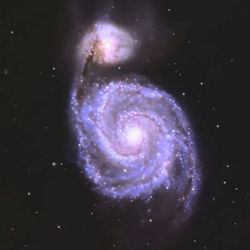None of these pictures were taken using a large telescope or from a remote dark sky site. Instead, they are all taken from my light-polluted backyard surrounded by nearby street lights and neighbors’ security lights.
Unless otherwise mentioned, all these images were taken using my Celestron RASA 8-inch astrograph (telescope) and a ZWO ASI183MC one-shot color camera. Originally I used an iOptron AZ Mount Pro alt-azimuth mount, but in 2023 I started using an iOptron HAE29ec equatorial mount. Image acquisition is controlled using software programs Sharpcap or NINA.
Nowadays the main program I use to process the raw images from the camera is Siril. (The earlier blog posts were mostly using a program named Startools.) The earliest images I show on this blog were formed from multiple short exposures (typically 3 seconds) stacked together to reach a total exposure of between 3 and 30 minutes. The more recent blog posts show images taken with longer total exposures, typically multiple 20 second exposures stacked together to reach a total exposure of 45-120 minutes.
A mini computer rides on my telescope to control the telescope and camera and it communicates with my main computer inside the house. I can see a detailed image in real time on my main computer screen (inside the house and away from the mosquitos or cold) and can watch the results improve as multiple exposures are taken and stacked together to produce a better image with less noise. And I can aim and focus the telescope remotely from the comfort of my study.
I should note that processing astronomical images to tease out as much subtle detail as possible is very much an art. Having only been doing this for a few years, I’m very much still in the “neophyte” category.
About Electronically Assisted Astronomy#
EAA allows amateur astronomers to observe objects in less than ideal conditions, especially under badly light polluted skies, or even when a bright Moon is present. Deep-sky celestial objects which are unimpressive or all but invisible in an eyepiece from urban or suburban skies easily become visible, with considerable detail, and in full color. By some informal estimates, EAA with a relatively inexpensive camera has the same effect as tripling telescope aperture for a visual observer without the drawbacks of a large bulky telescope. EAA is also ideal for us older observers whose visual acuity is not what it used to be.
About Astrophotography#
After I spent a couple of years using EAA to explore and sample what the sky has to offer, my interests evolved into spending more and more time doing longer-exposure astrophotography. Most of the images I’ve shared in the past couple of years have involved total exposures between 30 and 90 minutes and then more extensive post-processing afterwards. Some really impressive free software has recently come on the scene to facilitate final results, and learning to use it has been an ongoing endeavor. I should mention Siril, Sirilic, Graxpert, Cosmic Clarity, Astrosharp, SetiAstro and Affinity Photo in this regard.
I’m truly living in the golden age of amateur astrophotography – and still have a lot to learn!
Since the images in this blog are relatively large and contain a lot of detail, if you are using a phone or a small tablet, you might want to consider returning sometime when you can use a computer with its larger screen.
